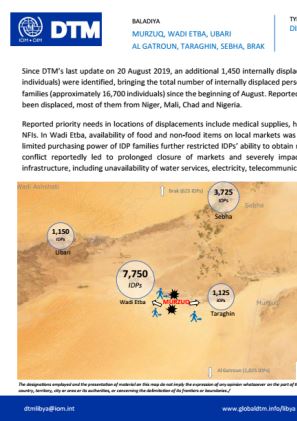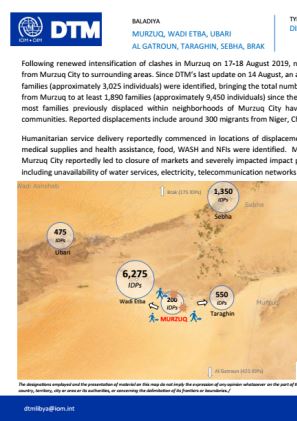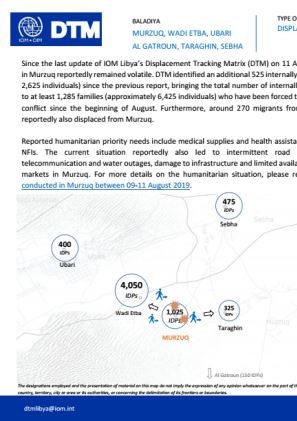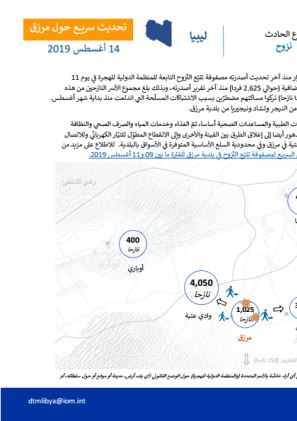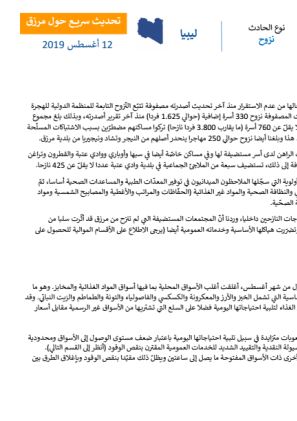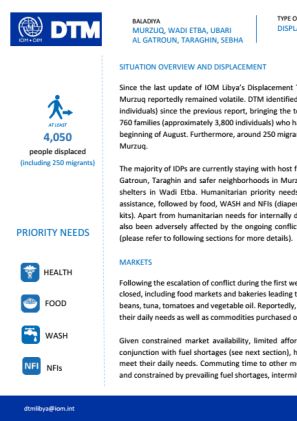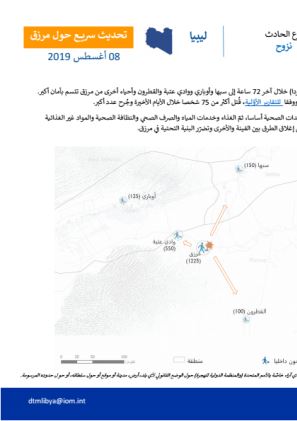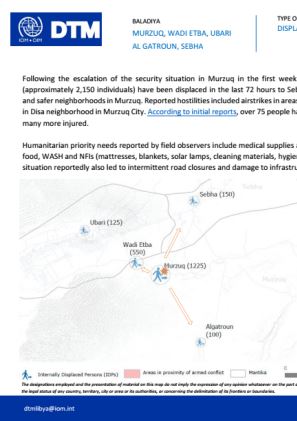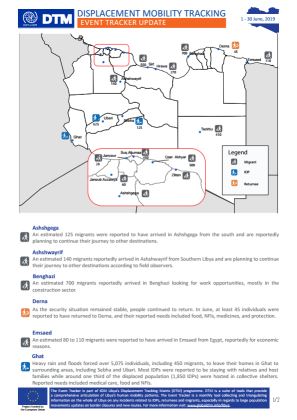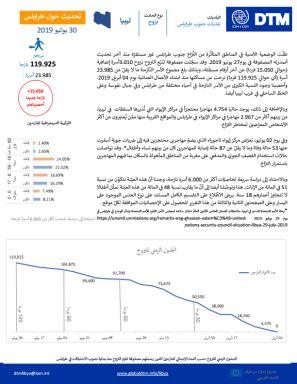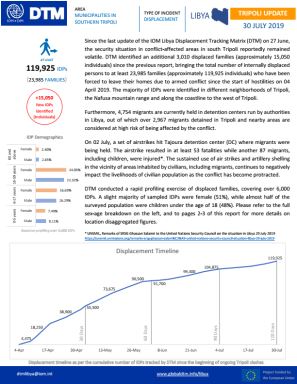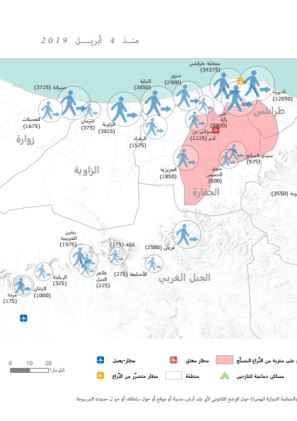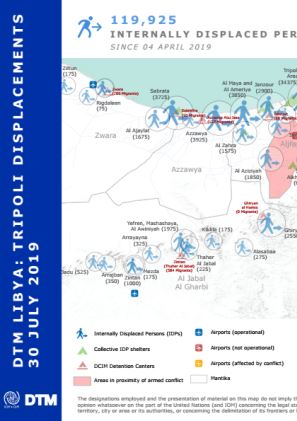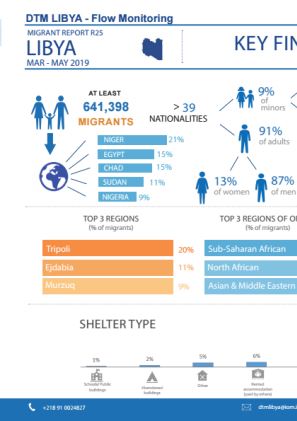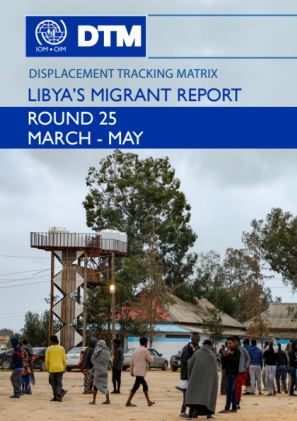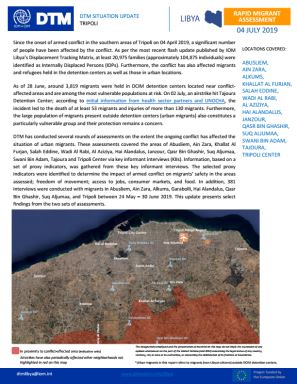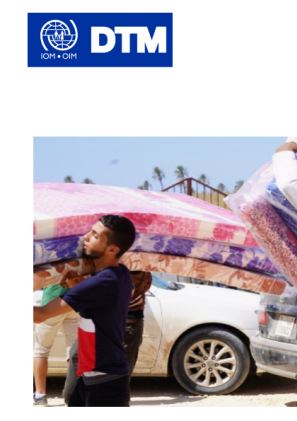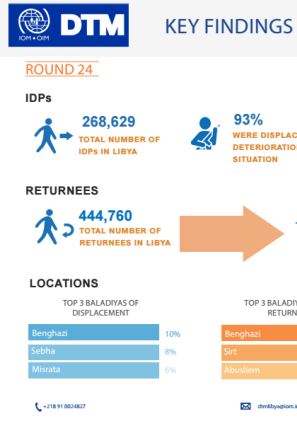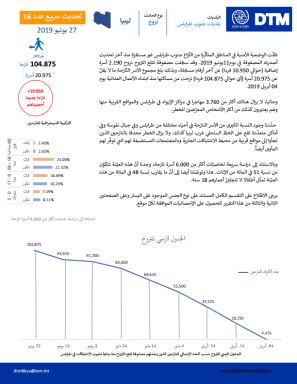-
Countries
-
Data and Analysis
-
Special Focus
-
Crisis Responses
Libya
À propos Libya
Libya is a geographically vast country with several regions that are difficult to access. In order to understand the full scope of humanitarian assistance that is needed throughout the country, IOM established the Displacement Tracking Matrix (DTM) programme in 2016 in order to provide a common operating picture concerning the movement of populations in Libya, allowing humanitarian actors to provide timely assistance to those in need. Following the escalation of conflict and insecurity in 2014, the security situation has remained volatile since with fluctuations in the intensity of localized clashes. Congruently, conflict has caused new displacements, often in areas ill-equipped to accommodate large population movements while also negatively impacting the large migrant population residing and transiting through Libya. More recently, the capital Tripoli was heavily affected by displacement waves in September 2018 and April 2019.
DTM’s mobility tracking and flow monitoring activities identified many migrants in-country to be in need of various forms of assistance. Libya’s geographic location, resources and work opportunities has made it both a country of destination and transit for migrants for many years. Despite the deterioration of the security situation since 2011 migrants continue coming to and transiting through Libya, the majority from Sub-Saharan and North African countries.
In this complex operating environment, DTM Libya has been providing a common operating picture concerning the movement of populations in Libya since 2016, allowing humanitarian actors to provide timely assistance to those in need. Through its mobility tracking, flow monitoring and needs assessment activities, DTM Libya has established itself as data hub for quantitative data on migratory flows to and within Libya, migrant presence in Libya disaggregated by nationality and area, as well as humanitarian needs of migrants, internally displaced population and returnees. All activities are implemented through periodical bi-monthly data collection cycles, allowing trend analysis over time to provide evidence-base for both policy-level discussions and to guide humanitarian action.
In order to facilitate humanitarian interventions, DTM works closely with IOM’s other programmes through referring identified populations in need of assistance at flow monitoring points to IOM’s Direct Assistance, Health, Voluntary Humanitarian Return (VHR), Protection and Migrant Rapid Response Mechanism (MRRM) programmes. Furthermore, DTM Libya supports other humanitarian partners through providing emergency tracking updates in case of sudden population movements as well as facilitating humanitarian assessments for the Rapid Response Mechanism (RRM) jointly implemented by IOM, UNICEF, WFP and UNFPA.
For more information on IOM's activities in Libya, please visit the IOM Libya country office website.
Contacter
DTM Libya
DTMLibya@iom.int
Bailleurs de fonds
- EUTF
Murzuq Flash Update (27 August 2019)
Since DTM’s last update on 20 August 2019, an additional 1,450 internally displaced families (approximately 7,250 individuals) were identified, bringing the total number of internally displaced persons from Murzuq to at least 3,340 families (approximately 16,700 individuals) since the beginning o
Aug 27 2019
Murzuq Flash Update (27 August 2019)
Libya — Detention Centre Profile Generator (July 2019)
Detention Centre Profiling is a component of IOM Libya’s Displacement Matrix programme.
Murzuq Flash Update (20 August 2019) [Arabic]
Following renewed intensification of clashes in Murzuq on 17-18 August 2019, new displacements were reported from Murzuq City to surrounding areas.
Aug 20 2019
Murzuq Flash Update (20 August 2019) [Arabic]
Murzuq Flash Update (20 August 2019)
Following renewed intensification of clashes in Murzuq on 17-18 August 2019, new displacements were reported from Murzuq City to surrounding areas.
Aug 20 2019
Murzuq Flash Update (20 August 2019)
Murzuq Flash Update (14 August 2019)
Since the last update of IOM Libya’s Displacement Tracking Matrix (DTM) on 11 August 2019, the security situation in Murzuq reportedly remained volatile.
Aug 15 2019
Murzuq Flash Update (14 August 2019)
Murzuq Flash Update (14 August 2019) [Arabic]
Since the last update of IOM Libya’s Displacement Tracking Matrix (DTM) on 11 August 2019, the security situation in Murzuq reportedly remained volatile.
Aug 14 2019
Murzuq Flash Update (14 August 2019) [Arabic]
Murzuq Flash Update (12 August 2019) [Arabic]
Since DTM Libya’s last update on 08 August 2019, DTM identified an additional 330 internally displaced families (approximately 1,650 individuals), bringing the total number of internally displaced persons from Murzuq to at least 760 families (approximately 3,800 individuals) who have been forced
Aug 12 2019
Murzuq Flash Update (12 August 2019) [Arabic]
Murzuq Rapid Assessment (12 August 2019)
Since DTM Libya’s last update on 08 August 2019, DTM identified an additional 330 internally displaced families (approximately 1,650 individuals), bringing the total number of internally displaced persons from Murzuq to at least 760 families (approximately 3,800 individuals) who have been forced
Aug 12 2019
Murzuq Rapid Assessment (12 August 2019)
Murzuq Flash Update (08 August 2019) [Arabic]
Following the escalation of the security situation in Murzuq in the first week of August, at least 430 families (approximately 2,150 individuals) have been displaced in the last 72 hours to Sebha, Ubari, Wadi Etba, Al Gatroun and safer neighborhoods in Murzuq.
Aug 09 2019
Murzuq Flash Update (08 August 2019) [Arabic]
Murzuq Flash Update (08 August 2019)
Following the escalation of the security situation in Murzuq in the first week of August, at least 430 families (approximately 2,150 individuals) have been displaced in the last 72 hours to Sebha, Ubari, Wadi Etba, Al Gatroun and safer neighborhoods in Murzuq.
Aug 09 2019
Murzuq Flash Update (08 August 2019)
Libya — Detention Centre Profile Generator (June 2019)
Detention Centre Profiling is a component of IOM Libya’s Displacement Matrix programme.
Libya — Displacement Event Tracking Report (1-30 June 2019)
DTM Displacement event tracking in Libya covers all the events related to population movements during one month. In June 2019, events related to displacements and population movements were recorded in 17 Muncipalities (Baladiyas) all over the country.
( التحديث 21 حول طرابلس (30 يوليو 2019
Since DTM’s last update on 27 June, an additional 3,010 displaced families (approximately 15,050 individuals) were identified, bringing the total to at least 23,985 families (approxim
Jul 30 2019
( التحديث 21 حول طرابلس (30 يوليو 2019
Tripoli Update 21 (30 July 2019)
Since DTM’s last update on 27 June, an additional 3,010 displaced families (approximately 15,050 individuals) were identified, bringing the total to at least 23,985 families (approxim
Jul 30 2019
Tripoli Update 21 (30 July 2019)
خريطة عدد 15 للنزوح من طرابلس
Since DTM’s last update on 27 June, an additional 3,010 displaced families (approximately 15,050 individuals) were identified, bringing the total to at least 23,985 families (approxim
Jul 30 2019
خريطة عدد 15 للنزوح من طرابلس
Tripoli Displacement Map #15 (30 July 2019)
Since DTM’s last update on 27 June, an additional 3,010 displaced families (approximately 15,050 individuals) were identified, bringing the total to at least 23,985 families (approximately 119,925 individua
Jul 30 2019
Tripoli Displacement Map #15 (30 July 2019)
Migrant Report Key Findings 25 (March — May 2019)
Round 25 Key findings
Libya — Migrant Report 25 (March—May 2019)
The 25th round of DTM data collection in Libya took place in March, April and May 2019. DTM identified at least 641,398 migrants who originated from more than 39 countries currently present in Libya. Migrants were identified in all 100 municipalities, within 565 communities.
Jul 10 2019
Libya — Migrant Report 25 (March—May 2019)
Libya —Tripoli Rapid Migrant Assessment (04 July 2019)
Since the onset of armed conflict in the southern areas of Tripoli on 04 April 2019, a significant number of people have been affected by the conflict.
Libya — Displacement Event Tracking Report (1-31 May 2019)
DTM Displacement event tracking in Libya covers all the events related to population movements during one month. In May 2019, events related to displacements and population movements were recorded in 20 Muncipalities (Baladiyas) all over the country.
Libya — IDP and Returnee Report 25 (April - May 2019)[ARABIC]
خلال ما بين شهري أبريل ومايو من سنة 2019 ، ارتفع عدد النازحين داخليا في ليبيا ارتفاعا كبيرا . من عدد 172.541 إلى 268.629 نازحا في آخر الجولة ال 25 وتعود حالات النزوح الجديدة خلال الفترة المشمولة بالتقرير إلى تصاعد الأعمال العدائية في جنوب طرابلس وإلى حركة النزوح المرتبطة بذلك.
Libya — IDP and Returnee Key Findings Report 24 (April-May 2019)
Round 24 Key Findings
Libya — IDP And Returnee Report 25 (April-May 2019)
This report presents the findings of round 25 of the mobility tracking component of the Displacement Tracking Matrix (DTM) programme in Libya, covering the reporting period 01 April until 31 May 2019.
( التحديث السريع عدد 20 لمصفوفة تتبع النزوح: النزوح من طرابلس (27 يونيو 2019
Since the last update of the IOM Libya Displacement Tracking Matrix (DTM) on 11 June, the security situation in conflict-affected areas in south Tripoli reportedly remained volatile.
Pagination
Pagination
- First page
- Previous page
- 1
- 2
- 3
- 4
- 5


